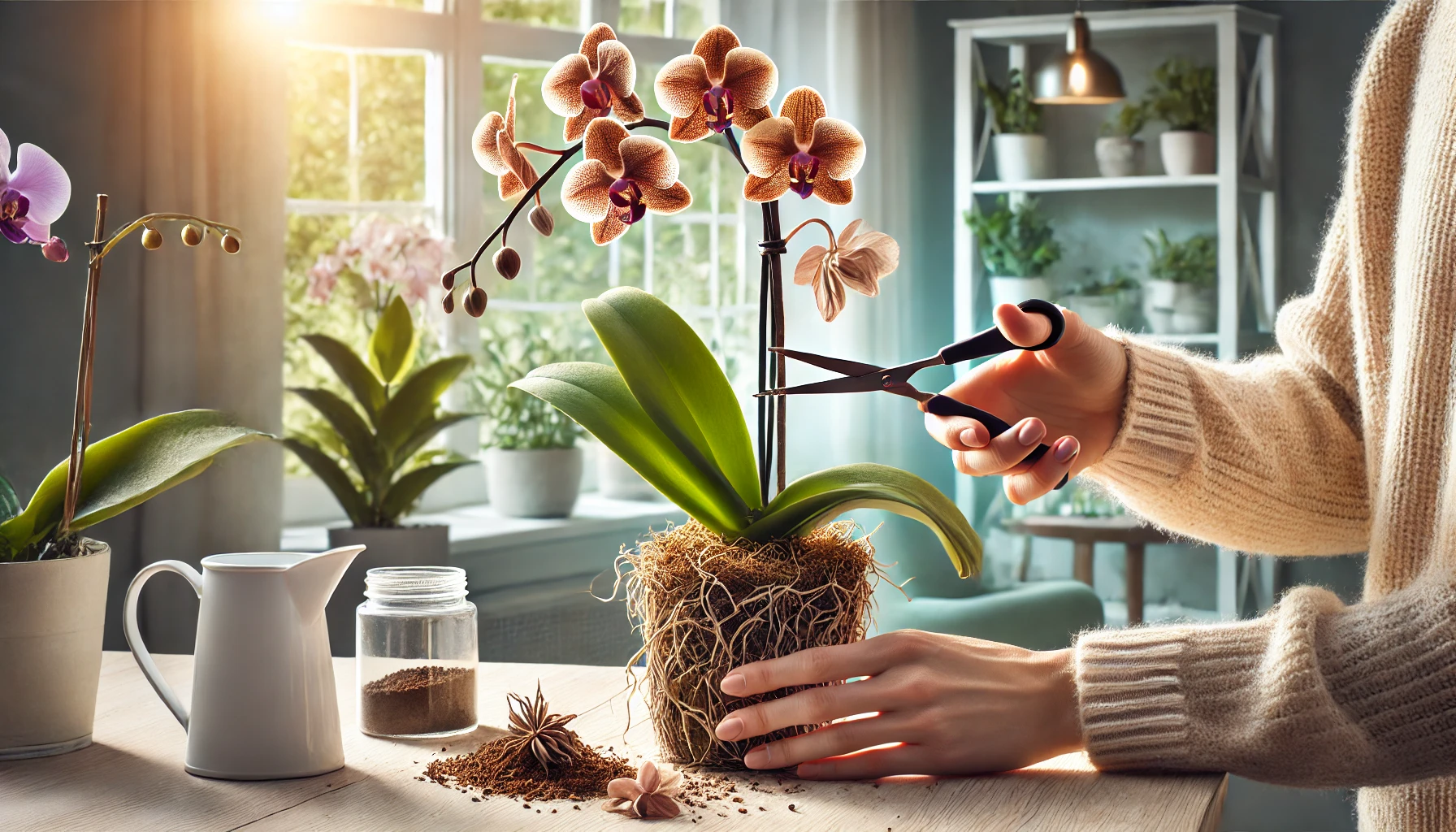One of the most common concerns for orchid owners is what to do when the flower spike dries out and turns brown. Many beginners worry that their plant is dying, but in reality, this is a natural part of the orchid’s life cycle. Knowing whether to trim, leave, or adjust care can help encourage healthy growth and future blooming.
🌱 Why Does an Orchid’s Flower Spike Dry Out?
An orchid’s flower spike, also known as a flower stem or inflorescence, may turn brown for several reasons. The most common cause is the natural end of the blooming cycle. However, improper care or environmental factors can also lead to a dried-out spike.
✔ Common Reasons for a Dry Flower Spike:
- End of the bloom cycle – Orchids naturally shed flowers, and the spike may dry up afterward.
- Lack of water or humidity – Dry air or underwatering can cause the spike to wither prematurely.
- Aging plant – Older orchids may stop producing flowers on an old spike.
- Too much direct sunlight – Sunburn can cause the spike to dry out faster.
💡 A dry flower spike does not mean your orchid is dead! The plant is simply entering a resting phase before its next bloom cycle.
✂️ Should You Cut Off a Dry Flower Spike?
Whether to cut the spike depends on its condition and the type of orchid. Some orchids can rebloom from the same spike, while others need a fresh one.
✔ If the spike is still green:
- Do not cut it—the orchid may rebloom from the same spike.
- If the tip is brown but the lower part is green, trim just above a node to encourage new flowers.
✔ If the spike is completely brown and dry:
- It will not rebloom, so trim it at the base near the leaves.
- Removing it helps the plant focus energy on new growth.
💡 For Phalaenopsis orchids, sometimes cutting just above a node can lead to a secondary bloom. For other orchids, like Cattleya or Oncidium, the spike should be cut off completely after flowering.
🌿 How to Properly Cut a Dry Flower Spike
If the spike is dry and brown, follow these steps to remove it safely:
✔ Use sterilized scissors or pruning shears to prevent infections.
✔ Cut the spike about 1 inch (2.5 cm) above the base.
✔ Apply cinnamon powder (a natural antifungal) on the cut area to prevent rot.
✔ Do not water the cut area directly for a few days to allow healing.
💡 Always use clean tools to prevent bacteria or fungus from entering the cut.
💧 Caring for an Orchid After Cutting the Flower Spike
Once the spike is removed, your orchid will enter a resting period (dormancy). This is when the plant builds up energy for future blooms. Proper care during this phase will ensure a healthy next flowering cycle.
✔ How to Care for an Orchid After Trimming the Spike:
- Reduce watering slightly—water every 7–10 days instead of weekly.
- Keep the orchid in bright, indirect light to support leaf and root growth.
- Maintain humidity at 50–70% to prevent dehydration.
- Fertilize once a month with a balanced orchid fertilizer (20-20-20).
💡 Patience is key! Most orchids take several months to rebloom, depending on their species and growing conditions.
🌸 How to Encourage a New Flower Spike to Grow
To trigger a new flower spike, you need to mimic the conditions that naturally stimulate blooming.
✔ Best Conditions for Reflowering:
- Temperature drop – Orchids like Phalaenopsis need cooler nights (55–65°F / 13–18°C) for a few weeks.
- Consistent lighting – Provide at least 10–12 hours of bright, indirect light daily.
- Bloom-boosting fertilizer – Switch to a 10-30-20 fertilizer when a new spike appears.
- Avoid moving the orchid – Sudden changes in location can stress the plant.
💡 A new spike usually emerges within 3–6 months, depending on the orchid’s health and environment.
🚫 Common Mistakes to Avoid
❌ Cutting a green spike too soon – If the spike is still green, leave it, as it may rebloom.
❌ Overwatering after cutting the spike – Less water is needed during the dormancy period.
❌ Ignoring root health – Weak roots can delay blooming, so check for signs of rot or dehydration.
❌ Skipping fertilizer – Even during dormancy, orchids need nutrients to regain strength.
🛡 Final Tips for Managing a Dry Flower Spike
✔ Identify whether the spike is completely dry before cutting.
✔ Always use sterilized tools when trimming to prevent infections.
✔ After cutting, adjust watering and fertilization to match the plant’s resting phase.
✔ Create the right conditions for reblooming, including cooler nights and bright light.
✔ Be patient—orchids can take months to develop a new flower spike, but proper care will encourage future blooms.
With the right approach, your orchid will recover from its dried flower spike and bloom again, bringing beauty to your home year after year! 🌸✨
